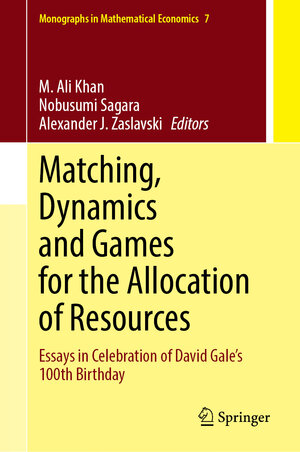
Matching, Dynamics and Games for the Allocation of Resources
Essays in Celebration of David Gale’s 100th Birthday
herausgegeben von M. Ali Khan, Nobusumi Sagara und Alexander J. ZaslavskiThis research book, dedicated to Professor David Gale on his 100th birthday, compiles significant new findings by renowned experts in mathematical economics related to Gale's work. The book is divided into three parts labelled as: „Economies and Games,“ „Economic Dynamics and Growth,“ and „Matching, Contracts, and Finance.“ These parts are introduced by the two surviving editors in an exploratory attempt to answer the question “Who is David Gale?”
The first part contains 9 chapters covering topics such as visibility design in network games, repeated games with tail-measurable payoffs, the existence of calibrated forecasts via the minimax theorem, revealed preference theory, the problem of obtaining permission when options partially ordered, an alternative proof for the existence of Haar measures on locally compact topological groups, equilibria of nonlinear production-consumption models, systemic risk in financial networks, and coalitional transferable utility extensions of the Gale–Mas–Colell economy.
The second part contains 7 chapters discussing topics like a generalization of the Pontryagin maximum principle in infinite horizon models, the Robinson–Shinkai–Leontief optimal growth model, dynamic CES production functions with a continuum of vintages of capital inputs across varying substitution elasticities, a two-country dynamic model, static and dynamic equilibrium in the Walrasian tradition, duality theorems in linear programming, and the turnpike phenomenon in the generalized von Neumann–Gale model.
The third part comprises 4 chapters exploring the relationship between stable and weakly setwise stable outcomes in many-to-many matching with contracts, a version of Gale and Shapley’s marriage market with a continuum of agents, the existence of stable contract systems between two complementary groups (e. g., workers and firms), and the general notions of upper and lower variances, initially introduced by Peter Walley for bounded random variables.



